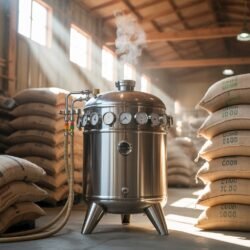Oen-air tank fermentation is likely to be replaced by sealed-tank (anaerobic) fermentation for several compelling reasons, all driven by the demand for more consistent, distinctive, and high-quality coffee profiles.
1. Greater Control Over Flavor Development
Sealed-tank fermentation allows producers to precisely control environmental variables such as oxygen levels, temperature, and microbial activity. This control enables the creation of unique, reproducible flavor profiles that are difficult or impossible to achieve in open-air tanks, where conditions fluctuate with the weather and external environment. By excluding oxygen, sealed tanks foster the growth of specific microorganisms that contribute to desirable flavors, while minimizing the risk of off-flavors and defects that can arise from unwanted microbial activity in open-air setups.
2. Consistency and Quality Assurance
Open-air tanks are subject to inconsistencies due to variable exposure to oxygen, temperature changes, and contamination risks. In contrast, sealed-tank fermentation provides a stable, controlled environment, leading to more consistent results batch after batch. This consistency is especially important for specialty coffee markets, where buyers expect reliable quality and unique sensory experiences.
3. Enhanced Flavor Complexity and Innovation
Anaerobic fermentation in sealed tanks encourages the development of complex and intense flavors, such as wine-like acidity, pronounced fruitiness, and enhanced sweetness, which are highly valued in modern specialty coffee markets. Producers can experiment with different fermentation times, temperatures, and even inoculate specific yeasts or bacteria to further customize flavor outcomes.
4. Reduced Risk of Spoilage and Contamination
Sealed tanks minimize the risk of contamination from airborne bacteria, molds, or insects, which can spoil coffee beans and lead to crop loss. This is a significant advantage over open-air tanks, where exposure to the environment is constant and harder to manage.
5. Alignment with Industry Trends and Consumer Demand
The specialty coffee industry is increasingly focused on innovation and traceability. Sealed-tank fermentation aligns with these trends by offering producers the ability to document and fine-tune their processes, resulting in coffees that stand out in a competitive market. Consumers are also drawn to the unique, often exotic flavors that anaerobic processing can produce, further driving demand for sealed-tank methods.
Conclusion
While open-air tank fermentation has served the coffee industry well for generations, the move toward sealed-tank fermentation is being driven by the desire for greater control, consistency, flavor innovation, and reduced risk. As producers and consumers continue to seek out new and exciting coffee experiences, sealed-tank (anaerobic) fermentation is poised to become the standard for premium specialty coffee processing.


